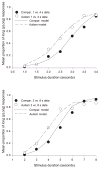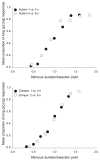Psychophysical assessment of timing in individuals with autism
- PMID: 21381951
- PMCID: PMC4822529
- DOI: 10.1352/1944-7558-116.2.165
Psychophysical assessment of timing in individuals with autism
Abstract
Perception of time, in the seconds to minutes range, is not well characterized in autism. The required interval timing system (ITS) develops at the same stages during infancy as communication, social reciprocity, and other cognitive and behavioral functions. The authors used two versions of a temporal bisection procedure to study the perception of duration in individuals with autism and observed quantifiable differences and characteristic patterns in participants' timing functions. Measures of timing performance correlated with certain autism diagnostic and intelligence scores, and parents described individuals with autism as having a poor sense of time. The authors modeled the data to provide a relative assessment of ITS function in these individuals. The implications of these results for the understanding of autism are discussed.
Figures



References
-
- Allman MJ, DeLeon . No time like the present: Time perception in autism. In: Giordano AC, Lombardi VA, editors. Causes and risks for autism. New York: Nova Science; 2009. pp. 65–76.
-
- Baddeley AD, Hitch G. Working memory. In: Bower GH, editor. The psychology of learning and motivation. Vol. 8. New York: Academic Press; 1974. pp. 47–89.
-
- Barkley RA. It’s About Time Questionnaire. Syracuse, NY: Author; 1998.
-
- Barkley RA, Koplowitz S, Anderson T, McMurray MB. Sense of time in children with ADHD: Effects of duration, distraction and stimulant medication. Journal of the International Neuropsychological Society. 1997;3:359–369. - PubMed
-
- Bebko JM, Weiss JA, Demark JL, Gomez P. Discrimination of temporal synchrony in intermodal events by children with autism and children with developmental disabilities without autism. Journal of Child Psychology and Psychiatry. 2006;47:88–98. - PubMed
Publication types
MeSH terms
Grants and funding
LinkOut - more resources
Full Text Sources

